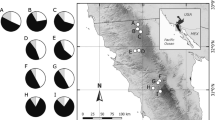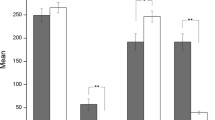Summary
Yucca moths are both obligate pollinators and obligate seed predators of yuccas. I measured the costs and net benefits per fruit arising for eight species of yuccas from their interaction with the yucca moth Tegeticula yuccasella. Yucca moths decrease the production of viable seeds as a result of oviposition by adults and feeding by larvae. Oviposition through the ovary wall caused 2.3–28.6% of ovules per locule to fail to develop, leaving fruit with constrictions, and overall, 0.6–6.6% of ovules per fruit were lost to oviposition by yucca moths. Individual yucca moth larvae ate 18.0–43.6% of the ovules in a locule. However, because of the number of larvae per fruit and the proportion of viable seeds, yucca moth larvae consumed only 0.0–13.6% of potentially viable ovules per fruit. Given both oviposition and feeding effects, yucca moths decreased viable seed production by 0.6–19.5%. The ratio of costs to (gross) benefits varied from 0% to 30%, indicating that up to 30% of the benefits available to yuccas are subsequently lost to yucca moths. The costs are both lower and more variable than in a similar pollinator-seed predator mutualism involving figs and fig wasps.
There were differences between species of yuccas in the costs of associating with yucca moths. Yuccas with baccate fruit experienced lower costs than species with capsular fruit. There were also differences in costs between populations within species and high variation in costs between fruit within populations. High variability was the result of no yucca moth larvae being present in over 50% of the fruit in some populations, while other fruit produced up to 24 larvae. I present hypotheses explaining both the absence and high numbers of larvae per fruit.
Similar content being viewed by others
References
Addicott JF (1979) A multispecies aphid-ant association: density dependence and species-specific effects. Can J Zool 57:558–569
Addicott JF (1981) Stability properties of 2-species models of mutualism: simulation studies. Oecologia (Berlin) 49:42–49
Addicott JF (1984) Mutualistic interactions in population and community processes. In: Price PW, Slobodchikoff CN, Gaud BS (eds) A new ecology: novel approaches to interactive systems. John Wiley & Sons, New York, pp 437–455
Addicott JF (1985a) Competition in mutualistic systems. In: Boucher D (ed) The biology of mutualism: ecology and evolution. Croom Helm, London, pp 217–247
Addicott JF (1985b) On the population consequences of mutualism. In: Case T, Diamond J (eds) Community Ecology. University of California Press, Berkeley, pp 425–436
Aker CL, Udovic D (1981) Oviposition and pollination behavior of the yucca moth, Tegeticula maculata, (Lepidoptera: Prodoxidae), and its relation to the reproductive biology of Yucca whipplei (Agavacae). Oecologia (Berlin) 49:96–101
Boucher DH, James S, Keeler KH (1982) The ecology of mutualism. Annu Rev Ecol Syst 13:315–347
Cronquist A, Holmgren AH, Holmgren NH, Reveal JL (1977) Intermountain Flora: Vascular Plants of the Intermountain West, USA The Moncotyledons, Vol. 6. Columbia University Press, New York
Davis DR (1967) A revision of the Moths of the Subfamily Prodoxinae (Lepidoptera: Incurvariidae). US Natl Mus Bull 255:1–170
Dean AM (1983) A simple model of mutualism. Am Nat 121:409–417
Force DC, Thompson ML (1984) Parasitoids of the immature stages of several southwestern yucca moths. Southwest Nat 29:45–56
Howe HF (1984) Constraints on the evolution of mutualisms. Am Nat 123:764–777
Janzen DH (1979) How many babies do figs pay for babies? Biotropica 11:48–50
Keeler K (1981) A model of selection for facultative nonsymbiotic mutualism. Am Nat 118:488–498
Keeley JE, Keeley SC, Swift CC, Lee J (1984) Seed predation due to the Yucca-moth symbiosis. Am Midl Nat 112:191–197
Kingsolver RW (1984) Population biology of a mutualistic association: Yucca glauca and Tegeticula yuccasella. Ph. D. Thesis. University of Kansas, p 125
Koch GG (1970) The use of non-parametric methods in the statistical analysis of a complex split plot experiment. Biometrics 26:105–128
Louda SM (1982) Inflorescence spiders: a cost/benefit analysis for the host plant, Haplopappus venetus Blake (Asteraceae). Oecologia (Berlin) 55:185–191
Mariscuilo LA, McSweeny M (1977) Nonparametric and Distribution-Free Methods for the Social Sciences. Brooks/Cole Publishing Company, Monterey, California, p 556
McKelvey SD (1938) Yuccas of the Southwestern United States, Part 1. The Arnold Arboretum of Harvard University, Jamaica Plain, Massachusetts, p 150
McKelvey SD (1947) Yuccas of the Southwestern United States, Part 2. The Arnold Arboretum of Harvard University, Jamaica Plain, Massachusetts, p 192
Miles NJ (1983) Variation and host specificity in the yucca moth, Tegeticula yuccasella (Incurvariidae): A morphometric approach. J Lepid Soc 37:207–216
Powell JA, Mackie RA (1966) Biological relationships of moths and Yucca whipplei (Lepidoptera: Gelechiidae, Blastobasidae, Prodoxidae), Univ Calif Pub Entomol 42:1–59
Riley CV (1892) The yucca moth and yucca pollination. Annu Rep Mo Bot Garden 3:99–159
Scheirer CJ (1976) The analysis of ranked data derived from completely randomized factorial designs. Biometrics 32:429–434
Southwick EE (1984) Photosynthate allocation to floral nectar: a neglected energy investment. Ecology 65:1775–1779
Udovic D, Aker C (1981) Fruit abortion and the regulation of fruit number in Yucca whipplei. Oecologia (Berlin) 49:245–248
Webber JM (1953) Yuccas of the southwest. US Dept Agric, Agric Monogr No 17, p 93
Author information
Authors and Affiliations
Rights and permissions
About this article
Cite this article
Addicott, J.F. Variation in the costs and benefits of mutualism: the interaction between yuccas and yucca moths. Oecologia 70, 486–494 (1986). https://doi.org/10.1007/BF00379893
Received:
Issue Date:
DOI: https://doi.org/10.1007/BF00379893




